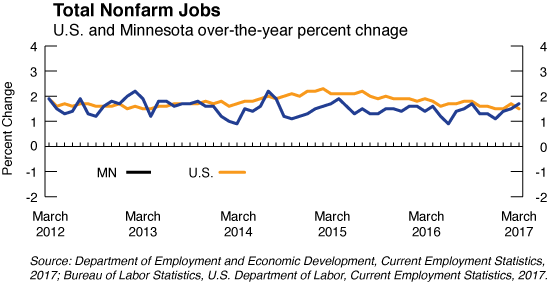by Nick Dobbins
April 2017
Monthly analysis is based on unadjusted employment data.
Employment in the Minneapolis-St. Paul-Bloomington MSA increased by 8,573 (0.4 percent) in March. That matched the highest monthly growth rate for any MSA in Minnesota, and outpaced the state’s monthly growth, which was at 0.3 percent. Mining, Logging, and Construction grew the fastest in March, up 2.5 percent (1,693 jobs), the highest growth rate in the state for that supersector. Specialty Trade Contractors drove that growth, adding 3,834 jobs (8.4 percent). Professional and Business Services added the most jobs, up 2,774 (0.9 percent). On an annual basis the metro area added 39,996 jobs (2.1 percent), which made it the fastest growing MSA in Minnesota on an over-the-year basis with 83 percent of Minnesota’s 48,162 new jobs since March of 2016. Mining, Logging, and Construction had the fastest growth in this time period as well, up 4.4 percent (2,948). Other supersectors with notable annual growth included Other Services (up 3.6 percent, 2,840 jobs) and Educational and Health Services (up 3.5 percent, 11,289 jobs). One notable dark spot for the MSA was Leisure and Hospitality, which lost 2,816 jobs (1.6 percent) on the year. While Arts, Entertainment, and Recreation added 1,008 jobs (3.4 percent), Accommodation and Food Services lost 3,824 (2.7 percent).
The Duluth-Superior MSA added 88 jobs (0.1 percent) in March. While most supersectors lost jobs in March, the biggest gains in the area came from Trade, Transportation, and Utilities (up 376 or 1.5 percent), where growth was able to overcome the employment declines in other area. The biggest decline, both proportionally and in total jobs lost, was in Educational and Health Services (down 155 jobs, 0.5 percent). Annually Duluth added 1,108 jobs (0.8 percent), a markedly slower rate than the statewide growth of 1.7 percent. The Mining, Logging, and Construction supersector saw the most dramatic growth, up 11.1 percent (876 jobs). The steepest annual declines occurred in Leisure and Hospitality, off 4.3 percent (570 jobs) from March 2016.
Employment in the Rochester MSA was up by 0.4 percent (430 jobs) in March. Professional and Business Services grew by 1.9 percent (104 jobs), and Trade, Transportation, and Utilities added 263 jobs (1.5 percent). Alternatively, Mining, Logging and Construction had the sharpest decline in the MSA, off by 1.8 percent (62 jobs). Rochester was one of only two MSAs in Minnesota to lose jobs in the supersector, which was the fastest-growing in the state overall. Annually Rochester added 558 jobs (0.5 percent). The fastest growth occurred in Financial Activities (up 111 jobs or 4.2 percent). Mining, Logging, and Construction shed 386 jobs (10.1 percent), while the entirety of the state added 6,428 jobs (6.2 percent), and every other MSA saw over-the-year growth in the area.
Employment in the St. Cloud MSA was down by 306 (0.3 percent) in March. Mining, Logging, and Construction was up 2.4 percent or 142 jobs, while Other Services was down 1.2 percent or 99 jobs. Other notable losses included Educational and Health Services (down 0.7 percent, 158 jobs) and Manufacturing (down 1.2 percent, 182 jobs). Annually St. Cloud added 1,097 jobs (1 percent). Mining, Logging, and Construction added 800 jobs (15.2 percent), and Educational and Health Services added 949 (4.4 percent). Leisure and Hospitality lost 583 jobs (6.7 percent), and Financial Activities lost 118 (2.4 percent).
The Mankato-North Mankato MSA lost 212 jobs (0.4 percent) in March. It was the greatest proportional over-the-month decline of any MSA fully within the state. Service providers lost 224 jobs (0.5 percent) while goods producers added 12 (0.1 percent). Government employment was off by 0.1 percent (7 jobs), and private sector employment was off by 205 (0.4 percent). Annually Mankato lost 171 jobs (0.3 percent). It was the only MSA in Minnesota to lose jobs over the prior 12 months. Goods producers added 238 jobs (2.5 percent), but that gain was erased by a loss of 224 jobs (0.5 percent) among service providers, specifically private sector service providers, which lost 614 jobs (0.6 percent).
Employment in the Fargo-Moorhead MSA was up by 0.1 percent (168 jobs) in March. Mining, Logging, and Construction added 177 jobs (2.2 percent). Professional and Business Services lost 385 (2.5 percent). Annually the Fargo-Moorhead MSA added 2,753 jobs (2 percent). By far the largest movement, both in proportional growth and total jobs, came in Educational and Health Services, which was up by 1,365 jobs (6.1 percent). The only supersectors to lose jobs were Trade, Transportation, and Utilities (down 95 or 0.3 percent) and Information (down 15, 0.5 percent).
The Grand Forks-East Grand Forks MSA lost 658 jobs (1.1 percent) in March. The losses were driven by the Mining, Logging, and Construction supersector, which shed 358 jobs (10.5 percent), although declines were widespread. Only two supersectors grew, Manufacturing (up 0.1 percent) and Other Services (0.3 percent), each of them adding just six jobs. Annually Grand Forks-East Grand Forks added 267 jobs (0.5 percent). Mining, Logging, and Construction added 311 jobs (11.4 percent) while Leisure and Hospitality lost 396 (6.2 percent).
